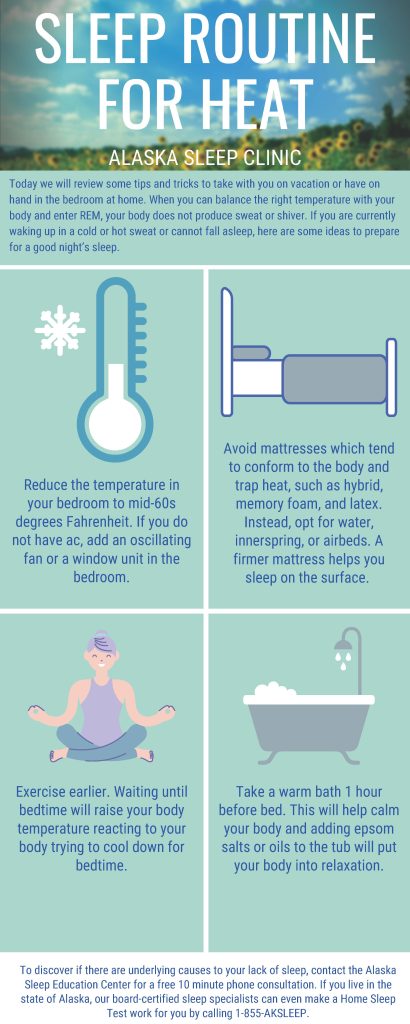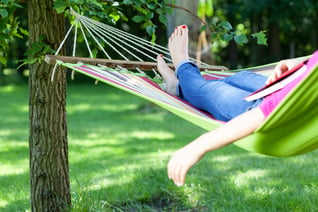Alaskans love the summer and the midnight sun, but summers also come with their own set of challenges – the heat. Here are a few tips to help you sleep through the warm nights comfortably.
-Air circulation. Keep your bedroom as comfortable as possible with airflow; open a window, turn on a fan, use air conditioning, or any other way to make the air move through the room and cool it down.
-Cool off before bed. Try to bring your overall body temperature down by taking a cool shower, or going for a swim.
-The right PJs. Wearing the right pajamas will help keep you cool at night and even wick moisture away from your body to help keep you more comfortable.
-Don’t work out. Avoiding intense exercise before bed will help you keep your core temperature down and make it easier for you to fall asleep.
-Skip the alcohol. Even if the alcohol makes you feel sleepy, it hinders the sleep process and has the potential to dehydrate you and make you feel even more tired in the morning.

Cool your bedroom all day.
For those with a Nest or similar thermostat, program your house to start cooling down in the bedrooms to 60 to 67 degrees Fahrenheit for optimal sleep. Lowering the thermostat will help regulate your body’s temperature while sleeping.
If you don’t have an air conditioner at this time, there are a few options available.
- One, you can spring for an inexpensive ceiling fan. Ceiling fans provide air circulation the entire year. In the wintertime, you can switch the rotation of the blades to distribute the heat and push it throughout the space of the room. But do not forget to switch the rotation for hotter temps: this way you can add more cool air to your room.
- Two, you can purchase a window unit for the bedroom. Keeping the bedroom door closed during the heat of the day with black-out curtains helps as well.
- Three, you can add an oscillating fan near the foot of the bed. Do not point it directly onto your face at night especially if you suffer from seasonal allergies. Again, blackout curtains can help with taking heat away from the room during the day.
Purchase the right ingredients for a cooler night’s sleep.
I get it: mattresses are not a cheap option to switch out because you are hot at night. Here is the good news: mattresses have trial periods. Take advantage of the hunt for a mattress by doing your homework and purchasing from a store or online that has an easy return policy. Some offer trial periods up to a year if you are not fully satisfied.

Avoid memory foam or mixed foam mattresses if you sweat or are hot at night. It also is best to avoid soft mattresses that cause your body to collapse in the bed. A firmer mattress helps you sleep on the surface.
Depending on the size and model, some air mattresses are more of a hassle than user-friendly. However, an air mattress is helpful when moving or transitioning to a new place.
Without the need for a headboard or footboard, the air mattress takes up less space and sets up quickly. A con to any inflatable device is leeks or wholes in the fabric. Take care when storing.
Make certain to purchase cooler pajamas in the summer like shorts or tank tops. You can even purchase a lighter-weight blanket for the summer and store your winter bedding in a vacuum-sealed bag to save on space.
A popular pillow for hot, sweaty sleepers, the gel pillow is cool at all times and all seasons providing extra-firm support to the head, neck, and shoulders. If contouring and bending are important in a pillow, the gel is not the choice for you.
Though no pillowcase is the wrong choice, think about your sleep positions. Cotton is the most breathable and luxurious choice due to the thread count options. Flannel could be a good option in the cold winter months along with your flannel sheets.
For some, silk is a good pillowcase that also keeps your hair in place during any type of restless sleep, but silk can stain easily from oils and are less breathable than cotton’s natural materials.
Add ambiance.
While some can endure a quiet sleeping space with earplugs, others benefit from soft music or white noise to fill the space. Air purifiers can serve not only the issues with an eerily quiet sleeping space but also filters out impurities, dander, and dust.
Classical music or soft sounds of a babbling brook, tree frogs, or a thunderstorm through a sound machine may be the ticket to adding some sound to the room without disrupting your heart rate.
With the addition of some noise in the room, your mind can focus on sleep than the heat.
Start a bedtime routine specifically designed for the heat.
- Reduce the temperature in your bedroom to mid-60s degrees Fahrenheit.
- Wear breathable clothing and use less bedding.
- Avoid mattresses that tend to conform to the body and trap heat, such as hybrid, memory foam, and latex. Instead, opt for water, innerspring, or airbeds.
- Get a firmer mattress.
- Exercise earlier. Waiting until bedtime will raise your body temperature reacting to your body trying to cool down for bedtime.
- Take a warm bath 1 hour before bed. This will help calm your body and adding Epsom salts or oils to the tub will put your body into relaxation.
Though a change in the routine of your bedroom temperature can help with a lack of sleep it could be another issue.
To discover if there are underlying causes to your lack of sleep, contact the Alaska Sleep Education Center for a free 10-minute phone consultation.
If you live in the state of Alaska, our board-certified sleep specialists can even make a Home Sleep Test work for you by calling us @ 907-357-6700.









